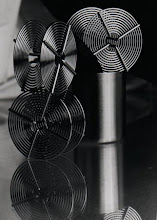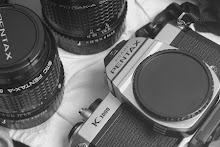Write down every camera setting, every time and temperature and mixture of negative processing, every enlarger setting and basic chemistry information about your printing. Soon, you will discover which of the settings are most influential for you; probably times and apertures.
Write down anything you can think of that might have influenced you to take a picture in that frame. This also goes for those who like the newer, digital processes. In fact, recording decisions made with the lengthy and detailed lists of computer functions digital photographers use might even be more important. User menus and software dialog boxes make switching electricity on and off, make deciding to do something so easy, that a computer-based photographer may not even realize how many, or what kind, of decisions he is making. All decisions about a given frame affect the outcome of an image one way or another. Our digital photographer brothers, too, could probably benefit from making some exposure notes in a notebook.
The notebook is the most important because when we get to the end of the process, when we are looking at those disappointing images, we often don’t accurately remember what we did to make them. I can usually remember about what I did; yet, I cannot accurately remember each and all of those influential camera settings used on just one roll of film. The notebook helps me. Recording what you did, immediately after you did it, will help to refresh your memory when it is time to edit those photographs.
I find that recording what I did in the darkroom to be the most helpful. Times and apertures and filter settings, all recorded, can help me to reproduce an image later with less testing and materials consumed. Camera setting information helps me to relate field decisions to the negative image. On the whole, the notebook is one of the most important items you can have.
An ability to measure the light is another. If your camera does not have a light meter, get one. If it does, understand everything you can about it. A spot meter works well; fortunately spot meter functions are built into many cameras produced after 1990. I now use a hand-held spot meter. I have cameras that have no light meter in them; I have been able to use one effectively because I had this spot meter on the scene. Using a hand-held spot meter also helped me to understand how my camera’s on-board TtL worked. They are a good investment.
I believe in spot meters so much that I would say that a good 1 degree-spot light meter is probably worth more than a second camera, no matter what model your first camera is. Something to think about. Regardless of which metering system you use, your exposure calculations can really benefit from understanding how the light is being reflected at the scene of composition. Not understanding exposure decisions, not really understanding exposure decisions, is bad news for someone who wants to make an image through a process that is going to involve so many subsequent decisions and steps.
You can trip the shutter while not knowing if you want; but there will be many decisions made about that image later, if you choose to use it. Just to carry it through to positive printing will involve many decisions. Consider knowing and understanding how that light flows into your camera. It can benefit you.
# # #






No comments:
Post a Comment